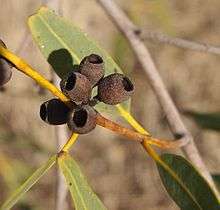Corymbia flavescens
| Corymbia flavescens | |
|---|---|
 | |
| Scientific classification | |
| Kingdom: | Plantae |
| (unranked): | Angiosperms |
| (unranked): | Eudicots |
| (unranked): | Rosids |
| Order: | Myrtales |
| Family: | Myrtaceae |
| Genus: | Corymbia |
| Species: | C. flavescens |
| Binomial name | |
| Corymbia flavescens K.D.Hill & L.A.S.Johnson | |
| Synonyms | |
| |

Corymbia flavescens, commonly known as the Scraggy Cabbage Gum, Wrinkle-leaf Ghost Gum,[1] Cabbage Ghost Gum, Apple Ghost Gum or the Bastard Ghost Gum,[2] is a species of plant in the myrtle family that is native to northern Australia, from the Kimberley region of Western Australia across the Northern Territory to western Queensland.[3]
The Jaru peoples know it as warlarri.[1]
Description
It grows as a tree up to 15 metres (49 ft) in height, with smooth, white, flaky bark.[3] The bark is powdery and sheds the tree in thin greyish to yellow coloured scales leaving vivid white behind. Adult leaves are concolorous or slightly discolorous, stiff, undulate, glossy and yellow-green in colour. The leaves are predominantly alternate with petioles that are 0.4 to 2 centimetres (0.16 to 0.79 in) long and a ovate to lanceolate shaped blade that is 6 to 23 cm (2.36 to 9.06 in) long and 1.3 to 7 cm (0.51 to 2.76 in) wide with a base tapering to petiole and a pointed apex.[1] It produces cream-white flowers from April to June, or in November.[3] The perfumed inflorescences are compound and axillary and later form a fruit that is pedicellate with pedicels that are 0.2 to 0.7 cm (0.08 to 0.28 in). The fruit is cupular to cylindrical to barrel-shaped with a length of 0.8 to 1.2 cm (0.31 to 0.47 in) and a width of 0.8 to 1.1 cm (0.31 to 0.43 in). Seeds are a dull to semi-glossy red or red-brown colour with a regular and flattened, patelliform and ovoid shape that is shallowly reticulate.[4]
C. flavescens has a lignotuber and will form an epicormic shoot in response to fire. As a result the tree has a lower than 30% mortality rate even if all of it's leaves are scorched during a bushfire.[5]
Distribution and habitat
It occurs on red earth soils, often along watercourses. In Western Australia it is found in the Central Kimberley, Dampierland, Great Sandy Desert, Northern Kimberley, Ord Victoria Plain, Pilbara, Tanami and Victoria Bonaparte IBRA bioregions.[3] In the Northern Territory it is found in the Davenport Murchison Ranges, Gulf Fall and Uplands, Mitchell Grass Downs, Mount Isa Inlier and Sturt Plateau IBRA bioregions.[1]
See also
References
- 1 2 3 4 "Corymbia flavescens K.D.Hill & L.A.S.Johnson". NT Flora. Northern Territory Government. 2013. Retrieved 7 October 2016.
- ↑ "Common Names". Euclid. Centre for Plant Biodiversity Research. Retrieved 7 October 2016.
- 1 2 3 4 "Corymbia flavescens". FloraBase. Western Australian Government Department of Parks and Wildlife.
- ↑ "Corymbia flavescens". EucaLink A Web Guide to the Eucalypts. Royal Botanic Gardens, Sydney. Retrieved 7 October 2016.
- ↑ "Fire responses of Corymbia flavescens". Northern Land Manager. Retrieved 7 October 2016.